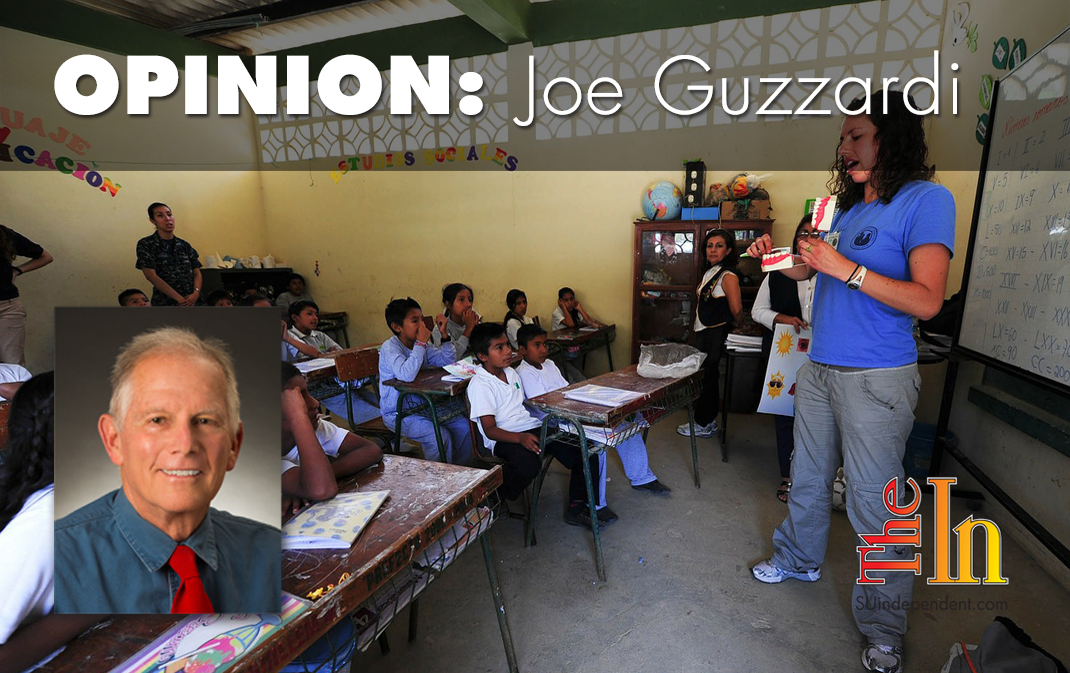
Immigration foils small-classroom fantasy in Los Angeles
If any reader can describe a more comic-tragic state than Los Angeles Unified School District teachers demanding smaller classroom sizes when their union — the United Teachers of Los Angeles, or UTLA — vigorously supports unlimited immigration, please contact me at the email listed below.
Last month, striking teachers approved a contract between their union and Los Angeles Unified School District officials that will give instructors a 6 percent pay hike, additional staff support, and — over a four-year period — smaller class sizes. As one teacher told CNN, “39, 42, 50” students are “stuffed” into a single room.
The details on how to get to those smaller class sizes will be worked out later, weasel words for nobody has a clue. And why everyone is clueless is because thousands of immigrant children flock into California’s public schools every year with the blessing of every official with decision-making power. Starting with Gov. Gavin Newsom and down to the local school principals, everyone, at least officially, is all in on immigration.
All are welcome in sanctuary state California, and the UTLA is among the most welcoming. The UTLA has hosted “Immigrants’ Rights for Educators,” and participated in “Freedom for Immigrants” and “Here to Stay” rallies, actions that belie searching for classroom overcrowding solutions.
Some legislative history partially explains how California’s schools got into the mess they’re in today. In 1982, the Plyler v. Doe Supreme Court decision ordered equal access to all children regardless of their immigration status. At about the same time that the Supreme Court handed down its decision, California’s legal and illegal immigrant population began to increase dramatically. Today, about half of the country’s 43.7 million immigrants live in California, Texas, and New York, with California accounting for 24 percent, or about 10.7 million, according to Pew Research. The state’s entire population is 39.8 million.
In 1994, Proposition 187, which would have denied some benefits to illegal immigrants, including public education, passed with 59 percent of the vote. But after immigration advocacy groups with the assistance of then-Governor Gray Davis filed several law suits, eventually Prop 187 was dead.
How much blame for California’s education failures can be attributed to the Supreme Court, Prop 187’s federal court scuttling, or the subsequent 25 years of unenforced immigration laws with myriad loopholes in the law that encourage immigration is hard to pinpoint. But bundle the three variables together and the explanation for California plunging from one of the nation’s most effective and respected public school systems to tenth from the bottom becomes apparent.
For the 2017–18 academic year, about 25 percent of LAUSD’s total enrollment is classified as English Learners. About 100 languages other than English are spoken in LAUSD: mostly Spanish, but also Korean, Armenian, Tagalog, Cantonese, Arabic, Vietnamese, and Russian.
Statewide, the EL breakdown is similar. Of the state’s 6.2 million enrollees, about 1.3 million are ELs. The California Department of Education doesn’t identify whether the non-English speaking students are legal immigrants’ children, the American-born citizen children of illegal immigrants, or illegal immigrants. But using the widely accepted cost-per-pupil rate of roughly $10,000 annually, California taxpayers spent approximately $10 billion last year and have spent hundreds of billions of dollars over the decades to educate non-English speaking students. That amount of money and teacher effort comes with at least some consequences to the mainstream students. A teacher has only so much time during a demanding day.
Going forward, if L.A. teachers truly want smaller classes, they must defy the UTLA on the grounds that it’s unreasonable and unfair to promote more immigration when so many existing students are already underserved.
The viewpoints expressed above are those of the author and do not necessarily reflect those of The Independent.
How to submit an article, guest opinion piece, or letter to the editor to The Independent
Do you have something to say? Want your voice to be heard by thousands of readers? Send The Independent your letter to the editor or guest opinion piece. All submissions will be considered for publication by our editorial staff. If your letter or editorial is accepted, it will run on suindependent.com, and we’ll promote it through all of our social media channels. We may even decide to include it in our monthly print edition. Just follow our simple submission guidelines and make your voice heard:
—Submissions should be between 300 and 1,500 words.
—Submissions must be sent to editor@infowest.com as a .doc, .docx, .txt, or .rtf file.
—The subject line of the email containing your submission should read “Letter to the editor.”
—Attach your name to both the email and the document file (we don’t run anonymous letters).
—If you have a photo or image you’d like us to use and it’s in .jpg format, at least 1200 X 754 pixels large, and your intellectual property (you own the copyright), feel free to attach it as well, though we reserve the right to choose a different image.
—If you are on Twitter and would like a shout-out when your piece or letter is published, include that in your correspondence and we’ll give you a mention at the time of publication.




Then why isn’t cnn reporting this every night like they did under the Trump administration